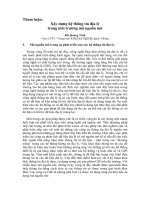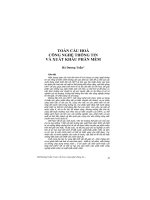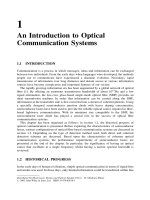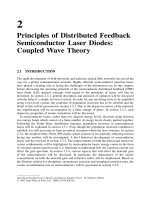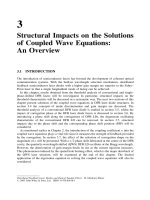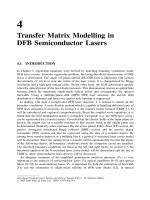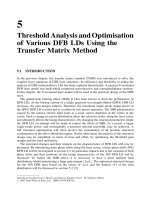Tài liệu Laser điốt được phân phối thông tin phản hồi và các bộ lọc du dương quang P1 ppt
Bạn đang xem bản rút gọn của tài liệu. Xem và tải ngay bản đầy đủ của tài liệu tại đây (357.79 KB, 30 trang )
1
An Introduction to Optical
Communication Systems
1.1 INTRODUCTION
Communication is a process in which messages, ideas and information can be exchanged
between two individuals. From the early days when languages were developed, the methods
people use to communicate have experienced a dramatic evolution. Nowadays, rapid
transmission of information over long distances and instant access to various information
sources have become conspicuous and important features of our society.
The rapidly growing information era has been augmented by a global network of optical
fibre [1]. By offering an enormous transmission bandwidth of about 10
14
Hz and a low
signal attenuation, the low-cost, glass-based single-mode optical fibre (SMF) provides an
ideal transmission medium. In order that information can be carried along the SMF,
information at the transmitter side is first converted into a stream of coherent photons. Using
a specially designed semiconductor junction diode with heavy doping concentration,
semiconductor lasers have been used to provide the reliable optical source required in fibre-
based lightwave communication. With its miniature size compatible to the SMF, the
semiconductor laser diode has played a crucial role in the success of optical fibre
communication systems.
This chapter has been organised as follows: in section 1.2, the historical progress of
optical communication is presented. Before exploring the characteristics of semiconductor
lasers, various configurations of optical fibre-based communication systems are discussed in
section 1.3. Depending on the type of detection method used, both direct and coherent
detection schemes are discussed. Based upon the characteristics of coherent optical
communication systems, the performance requirements of semiconductor lasers are
presented at the end of the chapter. In particular, the significance of having an optical
source that oscillates at a single frequency whilst having a narrow spectral linewidth is
reviewed.
1.2 HISTORICAL PROGRESS
In the early days of human civilisation, simple optical communication in terms of signal fires
and smoke was used. In those days, only limited information could be transferred within line
Distributed Feedback Laser Diodes and Optical Tunable Filters H. Ghafouri–Shiraz
# 2003 John Wiley & Sons, Ltd ISBN: 0-470-85618-1
of sight distances. In addition the transmission quality was strongly restricted by
atmospheric disturbances. This form of visual communication was extended and used in
the form of flags and signal lamps until the early 1790s, when a French scientist, Claude
Chappe [2] suggested a system of semaphore stations. Messages were first translated into a
sequence of visual telegraphs. These were then transmitted between tall towers which could
be as far as 32 km apart. These towers acted as regenerators or repeaters such that messages
could be transmitted over a longer distance. However, this method was slow and costly since
messages had to be verified between each tower.
With the beginning of a modern understanding of electricity in the 19th century, scientists
started to investigate how electricity might be used in long distance communication. The
telegraph [3] and telephone [4] were two inventions best representing this early stage of
the electrical communication era. During that period of time, optical communication in the
atmosphere received less attention and the systems developed were slow and inefficient.
The lack of suitable optical sources and transmission media were two factors that hindered
the development of optical communication. It was not until the early 1960s when the
invention of laser [5] once again stimulated interest in optical communication. A laser
source provides a highly directional light source in which photons generated are in phase
with one another. By modulating the laser, the coherent, low divergence laser beam enables
the development of optical communication. Due to the atmospheric attenuation, however,
laser use is restricted to short distance applications.
Long distance communication employing laser sources became feasible after a
breakthrough was reached in 1966 when Kao and Hockham [6] and Werts [7] discovered
the use of glass-based optical waveguides. By trapping light along the central core of the
cylindrical waveguide, light confined along the optical fibre could travel a longer distance as
compared with atmospheric propagation. Despite the fact that the attenuation of the optical
fibre used was so high, with virtually no practical application at that time, this new way of
carrying optical signals received worldwide attention. With improvements in manufacturing
techniques and intensive research, the attenuation of optical fibre continued to drop. Fibre
loss of about 4.2 db km
À1
was reported [8] for wavelengths around 1 mm, whilst low-loss
fibre jointing techniques also became available.
In order to build an optical communication system based on optical fibres, researchers in
the 1960s started focusing on the development of other optical components including optical
sources and detectors [9–11]. A new family of optical devices based on semiconductor
junction diodes was developed. By converting electrical current directly into a stream of
coherent photons, semiconductor lasers are considered to be reliable optical laser sources.
Based on similar working principles, efficient photodetectors based on the junction diode
were developed. By responding to optical power, rather than optical electromagnetic fields,
optical signals received are converted back into electrical signals. In this early phase of
development, semiconductor lasers used were restricted to pulse operation at a very low
temperature. It was not until the 1970s that practical devices operating in continuous wave at
room temperature became feasible [12].
The availability of both low-loss optical fibre and reliable semiconductor-based optical
devices laid the cornerstone for modern lightwave communication systems. In the late
1970s, lightwave systems were operated at 0.8 mm [13]. Semiconductor lasers and detectors
employed in these systems were fabricated using alluminium gallium arsenide alloy AlGaAs
[14]. Optical fibres used had a large core of diameter between 50 and 400 mm whilst typical
attenuation was about 4 dB km
À1
. At the receiver side of the system, direct detection was
2
AN INTRODUCTION TO OPTICAL COMMUNICATION SYSTEMS
used in which optical signals were directly converted to baseband optical signals. The
overall system performance was limited by the relatively larger attenuation and inter-modal
dispersion of the optical fibre used.
In order to reduce the cost associated with the installation and maintainence of electrical
repeaters used in the lightwave communication systems, it was clear that the repeater
spacing could be improved by extending the operating wavelength to a new region between
1.1 and 1.6 mm where the attenuation of the optical fibre was found to be smaller. Figure 1.1
shows the relation between the attenuation of a typical SMF and optical wavelength. For
systems operating at a longer wavelength, semiconductor optical devices were fabricated
using quantenary InGaAsP alloy. In order to avoid inter-modal competition associated with
high-order oscillation modes inside the optical fibre, optical fibres having a smaller core
diameter of about 8 mm were used. In this way, oscillation in an optical fibre was reduced to
single mode. For systems operating in such a longer wavelength region, both wavelengths at
1.3 and 1.55 mm have received a lot of attention. For systems operating near 1.3 mm, it was
found that the single-mode fibre used had minimum dispersion, and hence maximum
bandwidth could be achieved. In the early 1980s, many systems were built using single-
mode fibre at around 1.3 mm wavelength. An even lower fibre attenuation of about
0.2 dB km
À1
is found at around 1.55 mm. However, the deployment of lightwave systems in
the 1.55 mm region was delayed due to the intrinsic fibre dispersion which limits the
maximum bit rate the system can support. The problem was later alleviated by adopting
dispersion-shifted or dispersion-flattened fibre [15,16]. Alternatively, semiconductor lasers
oscillating in single longitudinal modes were developed [17,18]. By limiting the spread of
the laser spectrum, this type of laser is widely used in upgrading the 1.3 mm lightwave
Figure 1.1 Attenuation of silica-based optical fibre with wavelength (after [44]).
HISTORICAL PROGRESS
3
systems to 1.55 mm wavelengths in which conventional single-mode fibres were used. Since
1988, field trial tests for coherent lightwave communication systems have been carried out
[19–21].
In order to improve the bit rate of the present lightwave system whilst utilising available
fibre bandwidth in a better way, frequency division multiplexing (FDM) schemes [22] were
implemented. Before information is converted into optical signals, electronic multiplexing is
often applied in combining the signals. Such a system is normally referred to as coherent
optical communication since heterodyne or homodyne detection is used at the receiver end.
By mixing the incoming optical signal with an optical local oscillator, coherent detection
employs a different technique as compared with the direct detection method. In the 1980s,
the development of coherent optical communications was hindered due to poor spectral
purity and frequency instability in semiconductor lasers. Due to advances in fabrication
techniques, semiconductor lasers nowadays show improved performance.
In long-haul optical fibre communication systems, fibre dispersion and intrinsic
attenuation are two major obstacles that affect the system performance. In the 1990s,
optical fibre communication systems continued to develop in order to tackle these obstacles.
To circumvent the fibre dispersion, the non-linear optical soliton able to travel extremely
long distances was proven both theoretically [23,24] and experimentally [25,26]. By using
optical amplifiers [27,28] as pre-amplifiers, post-amplifiers and optical repeaters, one
witnesses the deployment of these wideband amplifiers in optical communication networks.
In the coming years, networks employing a densely spaced wavelength division
multiplexing (WDM) scheme [29] are expected. As a result, more channels and hence
more information will be transmitted over a single optical fibre link. There is no doubt that a
new paradigm of communication comprising an optically transparent network is already on
the way [30].
1.3 OPTICAL FIBRE COMMUNICATION SYSTEMS
By transferring information in the form of light along an optical fibre, a communication
system based on optical fibres starts to grow rapidly. This system, like many other
communication systems, consists of many different components. A simple block diagram
as shown in Fig. 1.2 represents the various components required in an optical fibre
communication system. At the transmitter side, information is encoded, modulated and is
then converted into a stream of optical signals. At the receiver side, optical signals received
are filtered and demodulated into the original information. For long distance applications,
repeaters or regenerators have to be used to compensate the intrinsic attenuation of optical
fibre. In order to maximise the amount of information that can be transferred over a single
optical fibre link, various multiplexing schemes might also be applied.
To ensure successful implementation of optical fibre communication links, careful
planning and system consideration is necessary. Apart from the performance characteristics
of every component used within the system, it is also necessary to consider interactions and
compatibility between various components. Depending on the system requirements, the type
of transmission (analogue or digital), required transmission bandwidth, cost and reliability,
may vary from one system to another. According to the type of detection method used at the
receiver end, it is common to categorise an optical fibre system into either a direct detection
or a coherent detection scheme.
4
AN INTRODUCTION TO OPTICAL COMMUNICATION SYSTEMS
1.3.1 Intensity Modulation with a Direct Detection Scheme
Simply by varying the biasing current injected into a semiconductor laser diode at the
transmitter, the so-called intensity modulation with direct detection (IM/DD) scheme was
widely adopted. The expression ‘intensity modulation’ derives from the fact that the
intensity of the light emitted at the transmitter side is linearly modulated with respect to the
input signal for either digital or analogue systems. The expression ‘direct detection’ is used
because the optical detector at the receiver end responds to optical power, rather than
electromagnetic fields as compared to radio or microwave links. In other words, all optical
signals received at the optical detector are demodulated into baseband electrical signals. Due
to its simplicity and low cost, the IM/DD transmission scheme has had great success, in
particular in point-to-point transmission systems. In order to explore the potential of the
optical spectrum, however, coherent detection has to be used.
1.3.2 Coherent Detection Schemes
Compared to the IM/DD transmission scheme, coherent optical communication [31–33] is
characterised by mixing the incoming optical signal with the local oscillator so that the
baseband signal (for homodyne detection) or an intermediate frequency (IF) signal (for
heterodyne detection) is generated at the receiver. Since spatial coherence of the carriers and
local oscillators is exploited, the expression ‘coherent’ is used to describe such a system
configuration. The advantages of coherent detection have long been investigated and were
recognised in the 1960s [34], but it was not until the late 1970s that single-mode
transmission from an AlGaAs semiconductor laser was demonstrated [35,36]. With a
Figure 1.2 Simple block diagram showing various components for optical fibre communication
systems.
OPTICAL FIBRE COMMUNICATION SYSTEMS
5
narrower spectral output, fibre-based lightwave systems employing coherent detection
became feasible.
Various digital modulation methods have been used in coherent optical communication,
including the amplitude-shift keying (ASK), the frequency-shift keying (FSK) and the
phase-shift keying (PSK) methods [37,38]. They differ from one another in the way digital
messages can be transmitted by variations in amplitude, frequency and phase, respectively.
For any digital transmission scheme and receiver architecture, a bit error rate (BER) in the
region between 10
À9
and 10
À10
must be achieved at the receiver side for a satisfactory
transmission.
The coherent optical communication system using homodyne/heterodyne detection has
several advantages over the IM/DD transmission scheme [39,40]. First of all, coherent
detection can improve the receiver sensitivity by about 15 to 20 dB, depending on the
modulation scheme adopted. As a result, spacing between repeaters is improved for long
distance communication, whilst transmission rates can be increased in existing long distance
links without reducing the repeater distance. Moreover, by using modulation like PSK or
FSK, which are well known in communication theory, the receiver can push to reach the
ideal quantum noise detection limit. In addition, by adopting densely spaced frequency-
division multiplexing (FDM) or wavelength division multiplexing (WDM), a wider fibre
bandwidth can be utilised. In practice, however, the coherent optical system has a stringent
requirement for device performance. In Fig. 1.3, a general block diagram for the coherent
optical communication system is shown.
As illustrated in Fig. 1.3, two injection lasers are involved in the system. One acts as a
transmitter and the other as a local oscillator. The laser transmitter which acts as an optical
frequency oscillator can be used directly in the FSK transmission. An external modulator is
optional for the ASK and the PSK transmission before the optical signals are launched into
the single-mode fibre (SMF). Optical amplifiers like semiconductor laser amplifiers (SLA)
or erbium-doped fibre amplifiers (EDFA) are used in long distance transmission for boosting
the signal.
Under the heterodyne receiver category with non-zero IF frequency, two different types of
postdetection process have been adopted. The name heterodyne receiver with coherent
postdetection processing (HE/CP) is usually given to one that has IF carrier recovered at the
receiver. Similarly, heterodyne receiver with incoherent postdetection processing (HE/IP)
describes the system that has no IF carrier recovered. Comparatively, the HE/IP receiver
Figure 1.3 Schematic diagram for the coherent optical communication system.
6
AN INTRODUCTION TO OPTICAL COMMUNICATION SYSTEMS
configuration is the simplest as IF carrier reconstruction is unnecessary. However, it shows
the weakest receiver sensitivity among the three receiver designs. The incoherent
postdetection process could be used in conjunction with several modulation schemes such
as ASK, FSK and differential phase-shift keying (DPSK). In the HE/CP receiver design, IF
signals are recovered at the receiver stage for further signal processing. The coherent
postdetection process can improve the receiver performance and so it is applicable to any
modulation method. However, it is substantially more complicated than the incoherent
method and stringent device performance is required.
For zero IF frequency, the homodyne receiver has the best receiver sensitivity as data is
recovered directly from the optical mixing process at the receiver. A narrower receiver
bandwidth and only baseband electronic processing are required. These offer significant
advantages to the homodyne receivers. In practice, however, the technologies required in
achieving these advantages in the homodyne receiver are demanding. An effective
synchronous demodulation process is essential in phase locking the local oscillator and
the received optical signal. Phase jitters caused by phase noise and shot noise could impair
the system performance easily. It has been evaluated [41] that the phase variance must be
limited to within $10
to ensure a lower power penalty for a BER 10
À9
. This sets an
upper limit on the permissible laser spectral linewidth and other laser performance
characteristics. In the coming sections, we are going to discuss some fundamental device
characteristics and their impact on system performance.
1.4 SYSTEM REQUIREMENTS FOR HIGH-SPEED OPTICAL
COHERENT COMMUNICATION
1.4.1 Spectral Purity Requirements
An ideal monochromatic laser source has been needed for some time. As a result, the
spectral purity of the laser source has often been the first issue confronting users of
semiconductor lasers in coherent optical communication. Due to the dispersive nature of the
optical fibres used, digital pulses are broadened whilst propagating along the optical fibre.
Such pulse spreading causes adjacent pulses to overlap so that errors occur as a result of
inter-symbolic interference (ISI). Thus, apart from the power limitation due to the intrinsic
fibre attenuation, the transmission distance is also limited by dispersion.
The use of single-mode fibres has eliminated the severe inter-modal dispersion of multi-
mode fibres. However, because of the finite spectral width of the optical sources, single-
mode fibre is limited by chromatic dispersion (or intra-modal dispersion). Since the laser
sources do not emit a single frequency but a band of frequency, each frequency component
of the field propagates with a different time delay in the single-mode fibre, causing a
broadening of the initial pulse width and hence intra-modal dispersion. The delay differences
in single mode fibre may be caused by the dispersive properties of material through variation
in the cladding refractive index (material dispersion) and also the guidance effects within the
structure (waveguide dispersion). In order to minimise the effect of dispersion in single-
mode fibre and hence improve the transmission distance, there are two different approaches.
The first method involves the use of a dispersion-shifted or dispersion-flattened fibre. With a
distinctive refractive index profile, these fibres can reduce the effect of dispersion at the
SYSTEM REQUIREMENTS FOR HIGH-SPEED OPTICAL COHERENT COMMUNICATION
7
1.55 mm wavelength significantly. Another possible way involves the improvement of
semiconductor laser sources. The ability to lase in single mode with a narrow linewidth can
circumvent the effect of dispersion. In the rest of this section, the concept of single-mode
operation, especially the possibility of a single longitudinal mode, will be discussed, whilst
the impact and the control of spectral linewidth will be left for later sections.
(a) Single mode along the transverse plane
It was shown in the previous section that the coherent optical communication system
requires semiconductor lasers that can emit at a monochromatic frequency in order to
achieve the required system BER. As a result, it is necessary to achieve a single-mode
oscillation in each of the orthogonal directions inside the laser cavity.
To understand the transverse waveguiding problem of semiconductor lasers, one must
start with electromagnetic wave theory the basis for the study of electromagnetic wave
propagation is provided by Maxwell’s equations [42]. For a medium with zero conductivity
the vector relationships may be written in terms of the electric field
~
E and magnetic field
~
H
as
rÂ
~
E ¼Àj!
~
H ð1:1Þ
rÂ
~
H ¼ j!"
~
E ð1:2Þ
where " and are the permittivity and permeability of the medium. The above equations are
expressed in the time harmonic form (with time variation term as e
j!t
) and are true for
source free and lossless media. By using the vector identity and taking the curl on both sides
of eqn (1.1), one can arrive at the scalar wave equation for the electric field E such that
r
2
~
E ¼Àk
2
~
E ¼À!
2
"
~
E
¼Àk
2
0
n
2
ðx; yÞ
~
E ð1:3Þ
where k is the propagation constant in the medium with the refractive index distribution of
n (x,y) and k
0
is the free space propagation constant.
Similarly, by taking the curl on both sides of eqn (1.2), one ends up with the scalar wave
equation for the magnetic field H.
r
2
~
H þ k
2
0
n
2
ðx; yÞ
~
H ¼ 0 ð1:4Þ
Either eqn (1.3) or (1.4) can be used to determine the field components as they are related to
one another by the Maxwell equations. Nevertheless, the scalar wave equation for the
electric field is often used as the electric field is responsible for most physical processes and
it is the principal field used by photodetectors.
To determine the transverse modal field of the semiconductor laser, one must first find the
thickness and the refractive indices of materials used in the fabrication process. Depending
on the specific laser structure, it is quite possible to have three or four epitaxial layers lying
on top of and below the active layer of the semiconductor laser. These laser structures may
look complicated at first glance. In fact, their waveguiding properties can be explained with
the use of a three-layer dielectric slab (or planar) waveguide. As shown in Fig. 1.4, the
8
AN INTRODUCTION TO OPTICAL COMMUNICATION SYSTEMS
asymmetric waveguide consists of three layers. The active layer, having refractive index n
1
and thickness d, is sandwiched between the substrate and the cladding of the waveguide.
Without loss of generality, it is assumed that the refractive indices of the slab waveguide
obey the following inequality
n
1
> n
2
! n
3
ð1:5Þ
where the equal sign implies a symmetrical waveguiding structure. With such a planar
structure, the field variation along the y-axis can be ignored and so @=@y ¼ 0. By separating
the Maxwell equations into different field components, the following equations are obtained
[42]
@E
y
@z
¼ j!H
x
ð1:6aÞ
@E
x
@z
À
@E
z
@x
¼Àj!H
y
ð1:6bÞ
@E
y
@x
¼Àj!H
z
ð1:6cÞ
À
@H
y
@z
¼ j!"E
x
ð1:6dÞ
@H
x
@z
À
@H
z
@x
¼ j!"E
y
ð1:6eÞ
@H
y
@x
¼ j!"E
z
ð1:6fÞ
The direction of wave propagation has always been assumed to be the longitudinal z
direction. By inspecting the above equations carefully, one can separate the above equations
into two groups. The first group includes E
y
, H
x
and H
z
from eqns (1.6a), (1.6c) and (1.6e).
The results generated from these equations are referred to as the TE mode since the electric
field is found along the transverse y-axis (normal to the propagation direction). The other
group includes H
y
, E
x
and E
z
, which generates solutions for the TM mode. An inspection of
the structure shows that either the TE or the TM mode is supported, but not both
simultaneously. Since there is no physical boundary along the y direction, the continuity
condition allows only H
z
or E
z
to exist.
Figure 1.4 Schematic cross-section of a slab dielectric waveguide. Refractive indices of different
regions are shown.
SYSTEM REQUIREMENTS FOR HIGH-SPEED OPTICAL COHERENT COMMUNICATION
9
For a travelling wave propagating along the z direction, the electric field takes the form
Eð
~
r; tÞ¼Eð
~
x;
~
yÞe
Àjb
z
~z
ð1:7Þ
where
~
r is the radial vector in space ðx; y; zÞ and the time harmonic term is omitted here for
the sake of simplicity. b
z
is the propagation constant at a fixed angular frequency ! which
can also be written as
b
z
¼ k
0
n
eff
ð1:8Þ
with n
eff
being the effective refractive index.
The electric field component E
y
for different layers in the slab dielectric can be obtained
by substituting eqn (1.7) into eqn (1.3) and putting @=@y ¼ 0. This is
@
2
@x
2
E
y
ðxÞ¼Àðk
2
0
n
2
1
À b
2
z
ÞE
y
ðxÞ¼Àh
2
E
y
ðxÞ; Àd x 0 ð1:9aÞ
@
2
@x
2
E
y
ðxÞ¼Àðk
2
0
n
2
2
À b
2
z
ÞE
y
ðxÞ¼p
2
E
y
ðxÞ; 0 x < 1ð1:9bÞ
@
2
@x
2
E
y
ðxÞ¼Àðk
2
0
n
2
3
À b
2
z
ÞE
y
ðxÞ¼q
2
E
y
ðxÞ; À1 < x Àd ð1:9cÞ
where h, p and q are constants defined as
h
2
¼ k
2
0
n
2
1
À b
2
z
p
2
¼ b
2
z
À k
2
0
n
2
2
q
2
¼ b
2
z
À k
2
0
n
2
3
ð1:10Þ
Depending on the relative values of n
1
, n
2
, n
3
,k
0
and b
z
, there are different regimes of
propagation constant as shown in Fig. 1.5.
Figure 1.5 Different types of modal solutions determined by the constants p, q and h. (after [44]).
10
AN INTRODUCTION TO OPTICAL COMMUNICATION SYSTEMS
If p
2
and q
2
are negative whilst h
2
is positive (i.e. 0 < b
z
< k
0
n
3
), the propagation is said
to be in the continuous radiation regime and the field solutions show sinusoidal behaviour in
all three layers. For a guided mode to occur, the constants p
2
,q
2
and h
2
must all be positive.
In other words, the inequality k
0
n
2
< b
z
< k
0
n
1
holds so that sinusoidal oscillation is
restricted to the central active layer while the electric field is decaying exponentially in other
layers. For the TE mode, a general formulation of E
y
ðxÞ takes the form
E
y
ðxÞ¼Ae
Àqx
; 0 x < 1
¼ A cosðhxÞþB sinðhxÞ; Àd x 0
¼ðA cosðhxÞþB sinðhxÞÞe
pðxþdÞ
; À1 < x Àd
ð1:11Þ
where A and B are two arbitrary constants that are related to the power of the propagating
mode. Since the tangential fields must be continuous at the dielectric interface, by
rearranging eqn (1.6c) such that,
H
z
¼
j
!
@E
y
@x
ð1:12Þ
the boundary conditions of the magnetic field H
z
at x ¼ 0 and x ¼Àd become
Aq þ Bh ¼ 0 ð1:13aÞ
A½h sinðhdÞÀp cosðhdÞ þ B½p sinðhdÞþh cosðhdÞ ¼ 0 ð1:13bÞ
On combining the above equations and eliminating the arbitrary constants A and B, we
arrive at the eigenvalue equation for the guided mode [43]
tanðhdÞ¼
ðp þ qÞh
h
2
À pq
ð1:14aÞ
From the above equation, it is clear that the active layer thickness d is decisive in
determining the guided mode. By replacing n
3
with n
2
(hence q ¼ p), the slab waveguide
becomes symmetrical and the above eigenequation becomes
tanðhdÞ¼
2ph
h
2
À p
2
¼
2p=h
1 À p
2
=h
2
ð1:14bÞ
By equating the last eigenvalue equation with the half angle trigonometric identity of
tanðxÞ¼
2 tanðx=2Þ
1 À tan
2
ðx=2Þ
ð1:15Þ
one can solve the quadratic equation in terms of tan ðhd=2Þ such that
tan
hd
2
¼
p
h
ð1:16aÞ
tan
hd
2
¼À
h
p
ð1:16bÞ
SYSTEM REQUIREMENTS FOR HIGH-SPEED OPTICAL COHERENT COMMUNICATION
11
Equations (1.16a) and (1.16b) represent the even and odd TE modes of the slab dielectric
waveguide. In order to solve the eigenequation for the TE mode, an extra equation is
necessary. By equating the propagating constants in eqns (1.10), one could obtain [44]
pd
2
2
þ
hd
2
2
¼ðn
2
1
À n
2
2
Þk
2
0
d
2
2
¼ D
2
ð1:17Þ
where D is defined as the normalised waveguide thickness.
Therefore, for a guided mode, the constants p and h must satisfy both eqns (1.14b) and
(1.17). Using a graphical method, these equations can be solved. Clearly, eqn (1.17)
represents a circle with radius D on the ðhd=2ÞÀðpd=2Þ plane. By putting in the odd and the
even TE mode eigenequations in the same ðhd=2ÞÀðpd=2Þ plane, we obtain the plot shown
in Fig. 1.6. Each intersection (or solution) with p > 0 and h > 0 between the circles and the
tangent function corresponds to a guided mode, from which the propagation constant could
be determined according to eqn (1.15).
Due to the periodicity of the trigonometric function, multiple modes may occur as the
frequency, and hence the radius of the circle, keeps increasing. From Fig. 1.6, there is only
one intersection point between the circle and the tangent functions when the normalised
waveguide thickness D has value
0 < D <
2
ð1:18Þ
Figure 1.6 Graphical method to solve the eigenequation for a symmetrical three-layer dielectric
waveguide. (after [44]).
12
AN INTRODUCTION TO OPTICAL COMMUNICATION SYSTEMS



